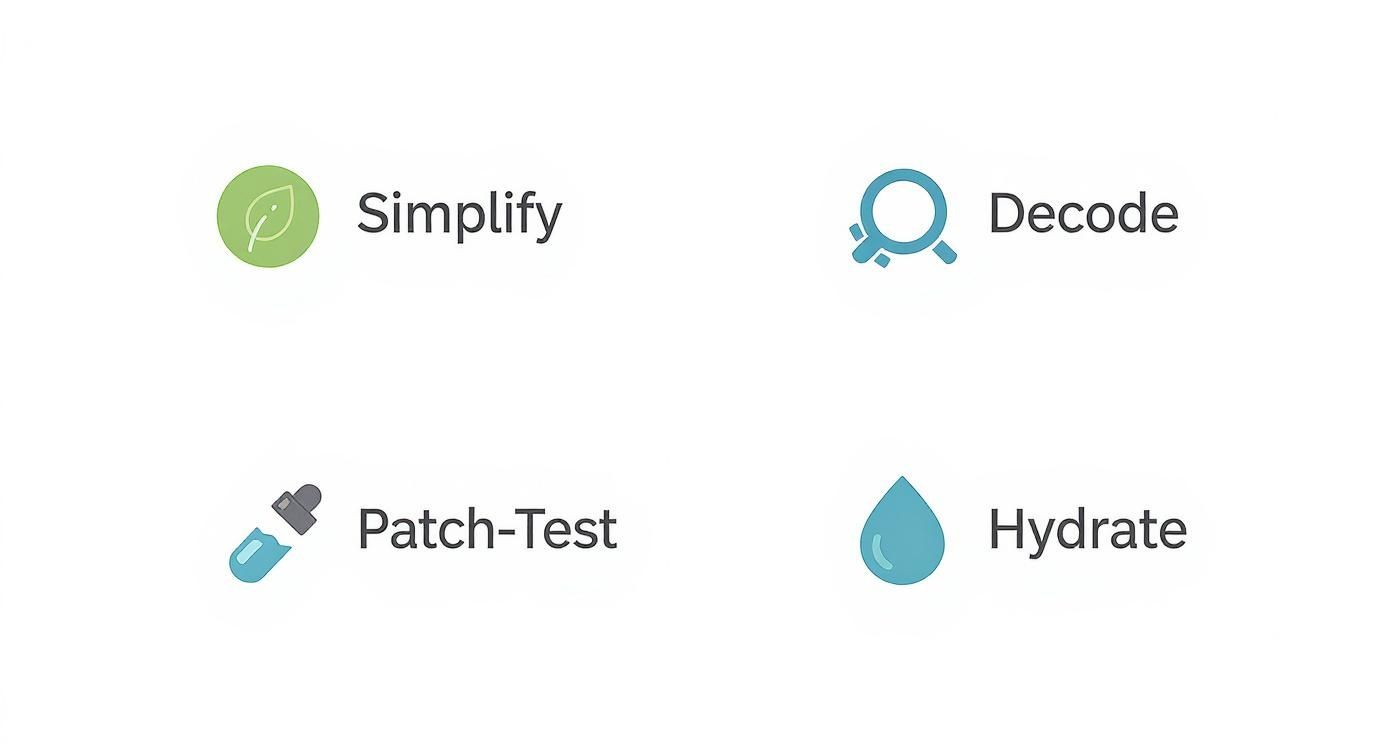How to Treat Sensitive Skin for Lasting Calm
- Web Dev
- 4 days ago
- 10 min read
Treating your sensitive skin isn't about finding a single miracle product you saw online. It’s a gentle, patient process centred on one core mission: soothing that awful irritation and rebuilding your skin’s natural protective barrier. This means stripping things back, getting to know what personally makes your skin flare up, and making hydration your absolute top priority. Think of it less as a battle and more as creating a calm, supportive environment where your skin can finally heal and breathe.
A New Way to Think About Your Sensitive Skin
If redness, irritation, and that constant feeling of discomfort have become your daily reality, please know this: you are not alone. It's so easy to see sensitive skin as an enemy, a frustrating obstacle to be fought and conquered. But what if we changed how we look at it?
Imagine your skin isn’t being difficult. It’s communicating with you. Every flare-up, every tight, itchy patch, is a message telling you exactly what it needs—and what it absolutely can’t tolerate. This small shift in perspective changes everything, moving you from a place of frustration to one of partnership.
And you are far from being alone in this. Here in the UK, a staggering 60% of people have dealt with a skin condition at some point in their lives. Globally, around 9% of people describe their skin as 'very sensitive'. If you'd like to learn more, the British Skin Foundation's website has some fascinating insights. This journey is about building a trusting relationship with your skin, turning a source of stress into a beautiful act of self-care.
The Four Pillars of Lasting Calm
To forge this new relationship, we're going to build it on four foundational pillars. These aren’t complex rules, but simple, guiding principles that will inform every choice you make. They’re your roadmap to a skincare practice that feels nurturing and empowering, leading to the calm, resilient complexion you deserve.
These pillars are the bedrock of effective sensitive skincare, helping you move from reactive crisis management to proactive, loving care.
The Four Pillars of Sensitive Skincare
Principle | Why It Matters for Your Sensitive Skin | Your First Action Step |
|---|---|---|
Simplify Your Routine | An over-burdened skin barrier is an irritated one. Using fewer products means you have fewer potential irritants and a much better chance for your skin to heal. | Pare your routine down to just the essentials: a gentle cleanser that doesn't leave your skin feeling tight, a soothing moisturiser, and a mineral SPF. That's it. |
Decode Your Triggers | Your skin’s reactions are clues. Figuring out what causes your flare-ups is the key to preventing them and finally getting some peace. | Start a simple skin diary on your phone. When a reaction happens, just note down new products, foods, or even stressful events from the day. |
Patch-Test Everything | A few minutes of testing can save you days (or weeks!) of widespread irritation and inflammation. Please don't skip this. | Before putting anything new on your face, apply a small amount to your inner arm or behind your ear. Wait 24-48 hours and check for any reaction. |
Prioritise Hydration | A well-hydrated skin barrier is a strong, resilient barrier. It’s your first line of defence against all the things that make your skin angry. | Look for hydrating heroes like hyaluronic acid, glycerin, and ceramides in your core products. Your skin will drink them up. |
By weaving these principles into your daily life, you take back control.
You’re no longer just reacting to flare-ups. Instead, you're proactively creating an environment where your skin can truly flourish. This is your path to predictable peace and lasting comfort.
Your Minimalist Routine for Maximum Calm
When it comes to your sensitive skin, the most powerful truth is this: less is truly more. Forget those overwhelming 10-step routines that fill your social media feeds. Our mission is to build a peaceful, predictable ritual with just a few core products that genuinely protect, soothe, and bring your skin back into balance.
This is all about creating a minimalist sanctuary for your skin. We'll strip it back to the absolute essentials: a cleanser that gently purifies without stripping your skin's barrier, a targeted serum to deliver calming hydration, and a comforting moisturiser to seal everything in. Think of it as a quiet return to basics, guided by what your skin actually needs.
This isn’t just about following steps; it’s about transforming your routine into a cherished moment of self-care, a time to reconnect with yourself and your skin.
Becoming an Ingredient Expert
Real confidence in managing your sensitive skin comes from understanding what you're actually putting on your face. It's time to become your own skin detective. Learning to read an ingredient list is like unlocking a superpower, allowing you to sidestep irritation before it even starts.
You’ll want to actively look for a few key heroes that bring comfort and strength. Ingredients like ceramides, which are lipids that help form the skin's barrier, and niacinamide, a form of vitamin B3 that calms inflammation, are brilliant. And you can never go wrong with a classic hydrator like glycerin. These are the ingredients that whisper peace to your skin.
On the flip side, it’s crucial to know the common culprits. To help you get started, here’s a quick guide to the friends and foes of sensitive skin.
Sensitive Skin Ingredient Guide: Friend vs Foe
Ingredient Category | Look For (The Friends) | Avoid (The Foes) |
|---|---|---|
Cleansers | Gentle surfactants (e.g., coco-glucoside), Hyaluronic Acid | Sodium Lauryl Sulfate (SLS), Harsh Scrubs |
Hydrators | Ceramides, Glycerin, Squalane, Hyaluronic Acid | Denatured Alcohol (Alcohol Denat.), SD Alcohol |
Soothing Agents | Niacinamide, Centella Asiatica, Panthenol, Allantoin | Fragrance (Parfum), Most Essential Oils, Dyes |
Actives/Exfoliants | Polyhydroxy Acids (PHAs), Lactic Acid (in low doses) | Glycolic Acid, Physical exfoliants with rough particles |
This table is your starting point. Knowing what to welcome and what to avoid is half the battle. If you want to dive deeper, you can explore our guide on the top skincare ingredients to avoid for healthier skin in 2025.
Imagine the confidence of picking up a product and knowing, instantly, whether it will support your skin or send it into a spin. This is the foundation of consistent, predictable calm.
The infographic below really brings together the core principles we’re building on.

These four pillars—Simplify, Decode, Patch-Test, and Hydrate—form an unbreakable foundation for taking back control and fostering a resilient, happy complexion. Every calm skin day you create is a victory, a testament to your gentle and consistent care.
Become a Detective to Uncover Your Triggers

With every flush of redness or moment of discomfort, your skin is trying to tell you something. Learning to decipher these messages is your secret weapon for achieving lasting calm. The real journey to happy, settled skin often starts not in your bathroom cabinet, but by looking at the rhythm of your everyday life.
Think back to your last flare-up. Was it after a particularly stressful week? Or maybe it popped up after you tried a new restaurant, or even switched your laundry powder? These aren't just random coincidences; they're valuable clues that you can use.
This is your chance to step into the role of a skin detective. When you get to the root of what's causing the irritation, you can sidestep flare-ups before they even think about starting.
Start Your Skin Investigation
Keeping a simple ‘skin diary’ can be an absolute game-changer. It doesn’t need to be fancy – a note on your phone or a few lines in a journal will do the trick. Whenever you notice a reaction, just quickly jot down a few key details.
Potential Culprits to Track:
Your Environment: Have there been sudden weather changes? A high pollution day? Or perhaps you spent all day in a heavily air-conditioned office?
What You’ve Eaten: Did you have more dairy, sugar, or spicy food than you normally would? Did that new supplement coincide with the rash?
Lifestyle Factors: How have your stress levels been? Are you sleeping well? Have you started a new, intense workout routine?
Household Products: That new fabric softener, air freshener, or even hand soap could be the hidden irritant.
This is exactly the kind of investigative work a professional would do. When you see an expert, you'll often fill out detailed esthetician client consultation forms that are designed to uncover these very connections.
Here in the UK, it’s worth noting that sensitive skin and allergies often go hand-in-hand. In fact, over 20% of the population is affected by at least one allergic disorder, which can absolutely manifest as a skin reaction.
By connecting the dots between your daily life and how your skin behaves, you take back the power. Each little discovery allows you to make small, meaningful changes that lead to profound, lasting relief.
Your Emergency Plan for Calming Flare-Ups Fast

Even with the most careful routine, flare-ups are a fact of life for those of us with sensitive skin. One minute you’re fine, the next your skin feels hot, tight, and furious. The key is not to panic, but to have a plan ready so you can act calmly and bring your skin back to a place of peace.
Your very first move should be to tackle the inflammation head-on. A cool compress is your best friend here. Just soak a soft flannel in cold water and gently press it against the angry areas for a few minutes. It provides instant relief from that awful burning sensation. Whatever you do, resist the urge to use ice directly on your skin – the extreme cold can be just another shock to your already stressed-out skin barrier.
With the immediate fire put out, it's time for a "skin reset." This is where you show your skin some real kindness.
Embracing the Skin Reset
The whole point of a reset is to strip everything back, removing any potential irritant to give your skin the space it needs to heal. For the next few days, this means simplifying your routine to the absolute bare minimum. Think of it as a gentle, hydrating cleanser and a simple, barrier-repairing moisturiser, and that’s it.
Consider this a quiet retreat for your skin. By pressing pause on all actives, exfoliants, and serums, you’re creating a calm environment where its natural healing process can finally take over without being disturbed.
While your routine is simplified, you can bring in some over-the-counter heroes to help things along. I’ve always found products containing Centella Asiatica (cica) to be brilliant for taking down redness. A spritz of thermal water throughout the day can also offer an immediate, cooling dose of hydration when you're on the go or at your desk.
You can even make a simple colloidal oatmeal mask at home to soothe any itching and irritation. This isn't just about damage control; it's about learning how to confidently and compassionately care for your skin when it needs you most. You are its greatest ally.
Lifestyle Rituals That Support Sensitive Skin
Truly resilient, calm skin is so much more than what you put on it. The real magic happens when you start looking at the bigger picture and nurture your body from the inside out. Think of it as creating a beautiful, supportive environment where your sensitive skin can finally relax and thrive.
It all begins with small, mindful choices that have a surprisingly big impact. Let's start with your daily shower. I know a steaming hot shower can feel like a dream, but that intense heat can be a nightmare for sensitive skin, stripping away its precious protective oils and leaving it feeling tight and irritated. Just turning the temperature down to lukewarm is one of the kindest things you can do for your skin. It’s a simple switch, but a powerful one.
Then, consider where you spend roughly eight hours every night: your bed. The fabric rubbing against your skin matters more than you might think. For ultimate comfort and to keep irritation at bay while you sleep, it's worth investing in luxury bamboo bedding designed for sensitive skin. The soft, breathable fibres minimise friction and help your skin stay calm all night long.
Nourish Your Skin From Within
What you put on your plate plays a starring role in your skin’s story. Fuelling your body with anti-inflammatory foods is like giving your skin barrier the exact tools it needs to rebuild and strengthen itself.
Think of it as your internal skincare routine. Berries, leafy greens, avocados, and fatty fish are all fantastic choices. They're packed with the nutrients that help soothe inflammation from within, creating a foundation for healthy, resilient skin.
Managing stress is another absolute non-negotiable. It’s not just in your head; there's a powerful mind-skin connection that science is really starting to understand. When you're stressed, your skin often shows it. I've seen firsthand how just five minutes of daily meditation, deep breathing, or a quiet walk can visibly calm down reactive skin. It’s incredible.
By harmonising your daily habits with your skin’s needs, you create a holistic environment of calm. These gentle rituals are not just tasks; they are your commitment to a more comfortable, radiant you.
For more deep-dive advice on building these healthy habits, be sure to check out our complete guide on how to maintain healthy skin in the UK.
Unpacking Your Sensitive Skincare Questions
When your skin is feeling fragile, it’s natural to have a million questions. It can feel like a bit of a minefield out there, but you’re not on your own. Let's clear up some of the most common queries we get, giving you the confidence to care for your skin beautifully.
How Long Before My Sensitive Skin Feels Better?
This is the big one, isn't it? While a soothing cleanser or a calming serum can bring some welcome, instant relief from that awful tight, prickly feeling, the real magic happens over time. Patience truly is a virtue here.
To see a genuine, lasting change in your skin's resilience, you need to give it a full skin cycle to heal and rebuild. That means sticking with a gentle, consistent routine for at least 28 to 40 days. Think of it as giving your skin the uninterrupted space it needs to repair its protective barrier and find its balance again. It can feel like a long time, but it's an investment in future calm.
Can I Still Use Actives Like Retinol?
Yes, absolutely! Having sensitive skin doesn't mean you have to miss out on the amazing benefits of powerful ingredients. It just means you have to be a bit more strategic and listen carefully to what your skin is telling you.
Follow these non-negotiable rules for introducing actives:
Start Low and Go Slow: Always, always begin with the lowest concentration you can find. Use it just once or twice a week to start, and only increase the frequency when you know your skin is happy.
Try 'Buffering': This is a brilliant technique. Simply apply your moisturiser first, let it sink in, and then apply your active. This creates a gentle buffer that softens the intensity without blocking the benefits.
Always Patch-Test: Before a new active goes anywhere near your face, test it on a small patch of skin, like behind your ear or on your inner arm, to check for a reaction.
When Should I See a Doctor?
Trust your gut. If you’ve simplified your routine, are using gentle products, and your skin still isn't improving, it’s time to call in the professionals. The same goes if the redness, pain, or irritation is starting to get you down or affect your daily life.
Your GP or a dermatologist can get to the bottom of what’s really going on. They can diagnose underlying conditions like rosacea or eczema and offer targeted, prescription-strength treatments that can provide the specialised support your skin truly needs. Don't struggle on your own if you don't have to.
At YOUTHFUL REVIVAL, we believe knowledge is the key to unlocking calm, healthy skin. If you’re looking for personalised advice and expert treatments designed for you, explore our services at https://www.youthfulrevival.com.

Comments